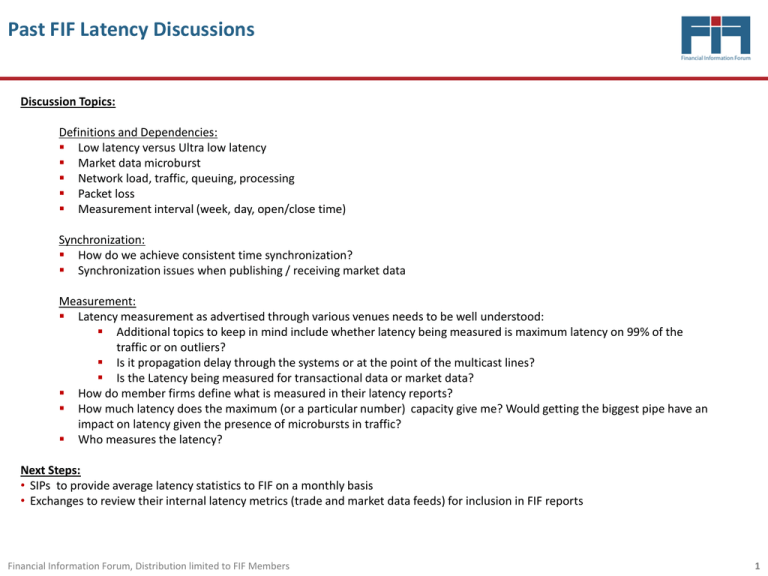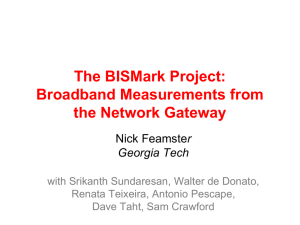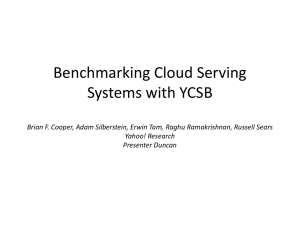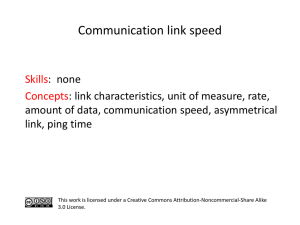Past FIF Latency Discussions - Financial Information Forum
advertisement

Past FIF Latency Discussions Discussion Topics: Definitions and Dependencies: Low latency versus Ultra low latency Market data microburst Network load, traffic, queuing, processing Packet loss Measurement interval (week, day, open/close time) Synchronization: How do we achieve consistent time synchronization? Synchronization issues when publishing / receiving market data Measurement: Latency measurement as advertised through various venues needs to be well understood: Additional topics to keep in mind include whether latency being measured is maximum latency on 99% of the traffic or on outliers? Is it propagation delay through the systems or at the point of the multicast lines? Is the Latency being measured for transactional data or market data? How do member firms define what is measured in their latency reports? How much latency does the maximum (or a particular number) capacity give me? Would getting the biggest pipe have an impact on latency given the presence of microbursts in traffic? Who measures the latency? Next Steps: • SIPs to provide average latency statistics to FIF on a monthly basis • Exchanges to review their internal latency metrics (trade and market data feeds) for inclusion in FIF reports Financial Information Forum, Distribution limited to FIF Members 1 Past FIF Latency Discussions Progress to Date: SIPs will provide average latency statistics to FIF on a monthly basis NYSE provided description of the types of metrics they capture for their matching engine/trading systems: CCG Latency for NYSE Classic: Calculate round trip latencies using CCG timestamps for the following messages: Order Ack, Cancel Replace Ack, Cancel Request, NX Fill, Cancel Confirm. Collect mean, std. dev, min, max, average, 90%, 95%, 99%. Arca Direct Latency Equities & Options: Calculate for each Gateway and Matching Engine, order ack latencies – mean, std. dev, min, max, average, 90%, 95%, 99%. Euronext, LIFFE Financials, LIFFE Equities and LIFFE US: Order Ack latencies – mean and std dev Latency Questions: Measurement of Latency by message type: Do different trade / market data messages matter? E.g. Order Ack, Cancel/Replace What is the ideal Unit of Measurement: Mean, Standard Deviation, Min, Max, Average, 90%, 95%, 99%? What is the impact of Clock Sync and Clock Drift based on timestamps from cross system calculations Where do you measure latency from - Internal (LAN vs WAN) vs Colo vs External (LAN vs WAN)? FIF Next Steps Obtain additional latency statistics: Additional Market Data Feeds Trading System / Matching Engine latency Agree to common latency measurement methodology Financial Information Forum, Distribution limited to FIF Members 2 Past FIF Latency Discussions Exchange Input – Latency Definition & Current Measurement Issues CTA / SIP Latency is measured from the time a message is received from an exchange to the time it takes to take that message and put it out to the multicast feed. The measurement is taken at the application level and begins the moment the message is received at the input server from an exchange to the time it is time stamped and put out on the multicast feed on the output server. SIPs measurement defined above is on application level. Also working towards measuring the time when data arrives from outside the network which is more important. Besides the average, also provide min, max, 90%, 95%, 99% percentile. Striving to get to the correct degree (include networking components, TCP/IP stack, etc). NASDAQ Currently use application based methodology from the time a message is received by the front end server from a UTP participant until the time it is put out on the multicast line going out. What is not included is network infrastructure and getting it out of the building and back in. Looking at options to be more comprehensive for measurements and provide characterization to this which is measuring percentile, mean, median. On direct feed: order-ack, cancel-ack and roundtrip latency for ITCH from outside (extranet switches). Published on NASDAQ at: http://nasdaqtrader.com/trader.aspx?id=inet and updated on a weekly basis. SIP data is in milliseconds which doesn’t really matter (even once when network components are included) because microseconds are more important. Other important issues include time synchronization and getting accuracy down, ideally deploying a tool to compare internal & external latencies Unable to obtain granularity from application timestamps, ideally utilize an external appliance. NYSE Difficult to measure between two systems that have different clocks which is why the appliance tools are a better idea than application timestamps (which sometimes can provide the required granularity), need taps on the outside to capture and analyze packets. Also looking at various latency management solutions. Financial Information Forum, Distribution limited to FIF Members 3 Past FIF Latency Discussions Exchange Input – Proposed Latency Measurement Methodology BATS Consider following points when talking about latency of a given feed: 1. Latency within market center / exchange / member 2. Latency from outside of market center / exchange network to outside of member’s network 3. Establish a consistent time source at each latency point to get accurate measurement of aggregate latency Work with all participants to get all three measurements. Put these pieces together and show total latency. Industry also wants to measure the speed of a matching engine/internal components of the market compared to FIX gateway? Ultimately interested in how fast it takes for the whole system to process either market data or trade traffic. If one is able to provide a consistent metric starting from outside the market’s firewall, that will be most valuable. BATS today provides statistics on the public website in real-time for members. Additional latency thoughts: Obtain market wide statistics in terms of different types of latencies across exchanges. Measure individual customer latencies which can be broken down into Different gateways Couple of paths Financial Information Forum, Distribution limited to FIF Members 4 Past FIF Latency Discussions Broker Dealer Input – Establish Framework for Latency Measurement Define latency vocabulary Order acknowledgement ,order cancellation, order modification latencies Matching engine, market data latency Measure latency during different times in a day (create a distribution curve) Market open, important economic announcements, market close Latency metrics of interest: max, min, standard deviation, 90%, 99.9% Create diagrams to define start and end points of measurement Latency survey Questions include: Which feeds provide source time stamps and where do they originate from? Identify start and end points of latency measurement Additional questions? Compare anonymous broker dealer statistics with exchange provided statistics FIF 2011 Latency Survey Report Available Financial Information Forum, Distribution limited to FIF Members 5







